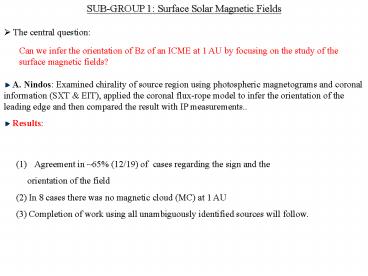SUBGROUP 1: Surface Solar Magnetic Fields - PowerPoint PPT Presentation
1 / 6
Title:
SUBGROUP 1: Surface Solar Magnetic Fields
Description:
Can we infer the orientation of Bz of an ICME at 1 AU by focusing on the study ... A. Nindos: Examined chirality of source region using photospheric magnetograms ... – PowerPoint PPT presentation
Number of Views:27
Avg rating:3.0/5.0
Title: SUBGROUP 1: Surface Solar Magnetic Fields
1
SUB-GROUP 1 Surface Solar Magnetic Fields
- The central question
Can we infer the orientation of Bz of an ICME at
1 AU by focusing on the study of the surface
magnetic fields?
- A. Nindos Examined chirality of source region
using photospheric magnetograms and coronal
information (SXT EIT), applied the coronal
flux-rope model to infer the orientation of the
leading edge and then compared the result with IP
measurements.. - Results
- Agreement in 65 (12/19) of cases regarding the
sign and the - orientation of the field
- (2) In 8 cases there was no magnetic cloud (MC)
at 1 AU - (3) Completion of work using all unambiguously
identified sources will follow.
2
- V. Yurchyshyn Test with two active region
cases - 11/7/04 X2.0 flare and CME event. Erupted
filament with a magnetic field orientation
roughly agreeing with the orientation of the MC - 4/9/01 System of loops disappeared in SXT. Their
orientation agreed roughly with the
orientation of the MC at 1 AU. - NOTE Both exercises are not automatic. Visual
inspection required. - Results
- (1) Two cases in which the orientation of the
erupting feature agreed with MCs' orientation - Additional test Compared the CME launch speed
with the Dst index of the subsequent
disturbances. As a result, Vasyl found that the
geoeffectiveness of an ICME seems to correlate
well with the CME's launch speed.
3
- Weve reached a consensus that surface magnetic
fields are indeed very useful in predicting the
geoeffectiveness of ICMEs, at least in some of
the events - HOWEVER
- We need more reliable ways to infer the coronal
magnetic fields (calculated or measured) - We need more reliable MC models
- The task is worthy but currently the technique is
not able to predict the geoeffectiveness of ICMEs
on a routine basis. The process is not automatic.
4
- M. K. Georgoulis A quantitative approach based
solely on the photospheric magnetic fields. An
array of tools applicable only to vector
magnetograms - Resolution of the 180-deg azimuthal ambiguity
- Calculation of the photospheric velocity field
vector as a solution of the ideal induction
equation - Evaluation of the energy-helicity formula in the
linear force-free approximation. Upgrade to a
nonlinear force-free method in preparation.
5
- RESULTS
- There seems to be significant quantitative
difference between flare/CME prolific active
regions and quiescent active regions in terms of
the total helicity budget and the percentage of
the free magnetic energy over the total magnetic
energy in the configuration - One case showed distinctive flow differences 30
min before a M2 flare and a CME - In one case of an X3 flare the total magnetic
helicity / free energy decreased after the event,
thus allowing a lower-limit estimation of the
events helicity and free energy content
- NOTES
- More active region cases obviously needed
- Large error bars in several cases because of the
lff approximation - Obviously, no mention about the geoeffectiveness
of CMEs. Combined studies required
6
- OVERALL CONSENSUS
- Magnetic helicity is an important tool for
understanding the process of CME initiation - However, there are still several gaps in the
understanding of the CME triggering process
moreover, several analysis tools need to be
refined - We need help! More people need to become
involved, and more data need to be contributed.
If the above results are backed up by a
sufficient statistical sample of cases, a
promising forecasting ability may emerge






























